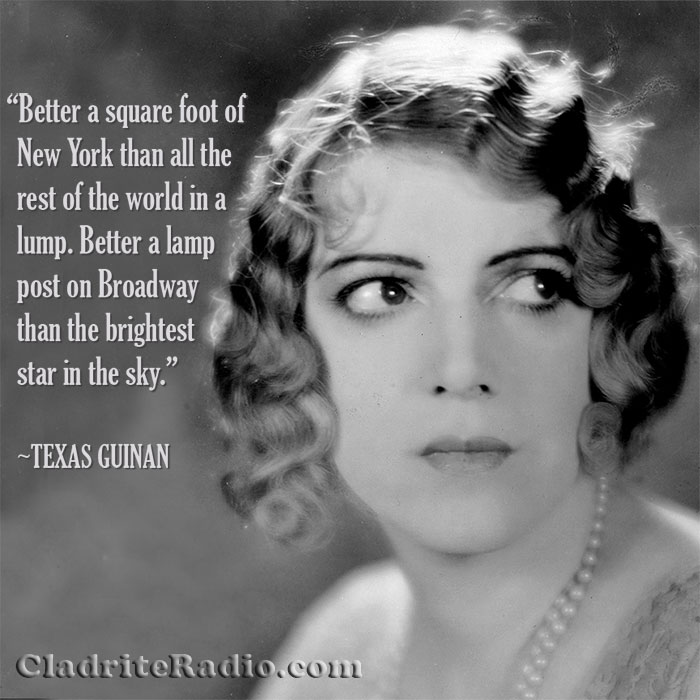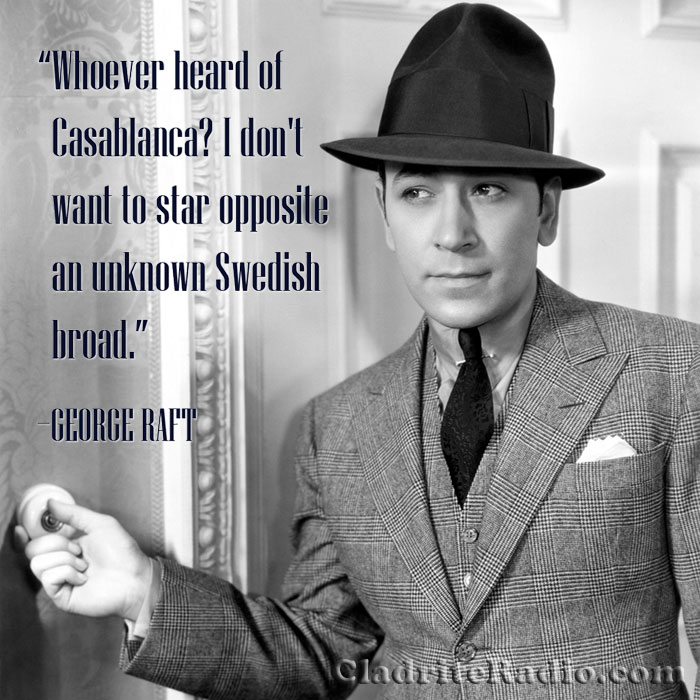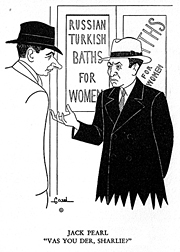Here are 10 things you should know about George Raft, born 119 years ago today. Raft is arguably as well known today for his association with mobsters as he is for his movies.
Tag: George Raft
10 Things You Should Know About Helen Vinson
Here are 10 things you should know about Helen Vinson, born 113 years ago today. Her Hollywood career was relatively brief—she appeared in just over three dozen movies—but memorable.
Happy 133rd Birthday, Texas Guinan!
Actress and Queen of the Nightclubs Texas Guinan was born Mary Louise Cecilia Guinan 133 years ago today in Waco, Texas. Here are 10 TG Did-You-Knows:
- Guinan was one of seven children. Her parents were Irish-Canadian immigrants. She attended parochial school at a Waco convent.
- When Guinan was 16, her parents moved the family to Denver, Colorado. There she began to appear in amateur stage productions before marrying newspaper cartoonist John Moynahan at age 20. The pair moved to Chicago, where she studied music. She eventually divorced Moynahan and began to perform in vaudeville as a singer.
- Guinan’s singing was reportedly no great shakes, but she had lots of pep and she soon found that she improved her prospects as a performer by regaling the audience with (perhaps exaggerated) tales of her “Old West” upbringing.
- In 1906, Guinan moved to New York City, where she worked as a chorus girl before finding additional work in vaudeville and on the New York stage.
- In 1917, Guinan made her movie debut and soon was a regular in western pictures. She is said to have been the first movie cowgirl (her nickname was The Queen of the West). Guinan would go on to appear in more than 50 features and shorts before she died in 1933.
- With the passage of the 18th Amendment, Guinan became active in the speakeasy industry, serving as hostess and emcee for a long string of illicit (but very popular) nightspots. Her outsized, sassy personality and her skill at evading justice, despite her many arrests for operating a speakeasy, made her a legendary figure in Prohibition-era NYC.
- Guinan’s speakeasies featured an abundance of scantily clad fan dancers and showgirls, but her penchant for pulling the legs of the rich and famous served her just as well. “Hello, suckers!” became her standard exclamation for greeting customers. Her well-to-do patrons she referred to as her “butter-and-egg men” and she coined the familiar phrase “Give the little ladies a big hand” while serving as emcee.
- Texas Guinan’s nightclubs were often backed by gangster Larry Fay and such legendary bad guys as Arnold Rothstein, Owney Madden and Dutch Schultz frequented her establishments—alongside relatively “good guys” such as George Gershwin, Walter Chrysler, Pola Negri, Mae West, Al Jolson, Gloria Swanson, John Gilbert, Clara Bow, Irving Berlin, John Barrymore and Rudolph Valentino.
- Ruby Keeler and George Raft both got their starts in show business as dancers as Guinan’s clubs, and Walter Winchell acknowledged that the inside access Guinan gave him to Broadway’s cornucopia of colorful characters helped launch his career as a gossip columnist.
- Guinan died of amoebic dysentery in 1933, one month before Prohibition was repealed. She was just 49. Bandleader Paul Whiteman and writer Heywood Broun were among her pallbearers.
Happy birthday, Texas Guinan, wherever you may be!

Happy 115th Birthday, George Raft!
Actor George Raft was born George Ranft 115 years ago today in the Hell’s Kitchen section of New York City. Raft is perhaps as well known today for the movie roles he turned down as those he accepted. Here are 10 GR Did-You-Knows:
- His parents were of German descent.
- From his youth, Raft took a great interest in dancing, and his skills as a hoofer would serve him well as he found his way as a performer. In his salad days, he made money performing (and dancing with the lady patrons) at establishments such as Maxim’s, El Fey (with Texas Guinan) and various other night spots.
- He married Grace Mulrooney, who was several years his senior, when he was 22. They separated early on, but never divorced (perhaps because Raft’s family was Catholic), and he supported her until she died in 1970.
- Raft was known to run with a pretty rough crowd. He was childhood friends with gangsters Owney Madden and Bugsy Siegel; Siegel stayed at Raft’s home in Los Angeles when the gangster first moved there.
- Raft reportedly turned down the lead roles in High Sierra (1941), The Maltese Falcon (1941), Casablanca (1942) and Double Indemnity (1944). The first three of those roles proved to be great successes for Humphrey Bogart.
- Raft appeared in Mae West‘s first (Night after Night, 1932) and last (Sextette, 1978) pictures.
- In James Cagney‘s autobiography, the actor wrote that Raft prevented Cagney from being rubbed out by the mob. Cagney was president of the Screen Actors Guild at the time, and the story goes that he was adamant the Mafia wouldn’t become active in the union’s affairs, which was not a popular stance in certain circles.
- Raft was a lifelong baseball fan, attending the World Series for 25 years in a row in the 1930s, ’40s and ’50s.
- As a teen, Raft was a bat-boy for the New York Highlanders (later the Yankees).
- In the late 1950s, Raft worked as a celebrity greeter at the Hotel Capri, a Mafia-owned casino in Havana. He was there in 1959 when rebels stormed Havana to overthrow dictator Fulgencio Batista.
Happy birthday, George Raft, wherever you may be!

In Your Hat, pt. 8
Here’s Chapter 8 of In Your Hat, the 1933 tell-all memoir by Hat Check Girl to the Stars, Renee Carroll, in which she shares tales of by the many celebrities she encountered while working at Sardi’s, among them George Burns and Gracie Allen, Eddie Cantor, George Jessel, Norma Talmadge, George Raft, Wallace Reid, Ginger Rogers, Douglas Fairbanks, and many more.

A STOOGE, in Broadway parlance, is the assist in the act. If you do an accordion routine and a heckler is paid by you to annoy your act from the box, then you’re probably Phil Baker and your stooge eventually becomes as famous as you are. Witness Sid Silvers of Take a Chance fame.
Broadway is full of stooges, both in real life and on the stage. It may sound strange to you but the jester in the king’s court from the time of The Erl King (I don’t know why they insist on spelling Oil as Erl) has been brought down the years until now he is labeled “stooge.” His job is to take he hard knocks, furnish the opportunity for the gag to be sprung, and appear the perfect fool.
When Phil Baker, who pumps a mean accordion, opened in a show in New York and had a stooge in the box doing the regular routine, Al Boasberg, the gagman who writes funny lines for a dozen or more comedians, wired Baker:
| LIKED YOUR ACT STOP THE OLD GENT WITH THE ACCORDION WAS GOOD TOO. |
Gracie Allen, of the famous team of Burns and Allen, is the stooge of the act, even though it is she who pulls all the funny lines. Recently she gave George Burns cause to laugh when she came to him with an idea.
“Georgie, dear,” Gracie said. “I have an idea.”
“Well, let’s forget it,” George answered characteristically, knowing it would bring on the usual headache.
“I’ve thought of a line for our act,” she continued.
“All right,” gave in George. “What is it?”
“I can’t tell you until I’ve gotten a prop.”
“What sort of a prop?”
“A muff.”
“What’s a muff?” George wanted to know.
“It’s one of those things women used to carry around so that they could hold hands with themselves.”
“All right, Gracie, get yourself a muff and let’s have the gag.”
She went to the best furrier on the Avenue and ordered a muff made. It has to be matched sables, four skins, exquisitely sewn. The muff cost $250 and she charged it to Geroge Burns, her husband. She brought it to him one day.
 “Here’s the muff, George.”
“Here’s the muff, George.”He examined it carefully. He approved.
“I got it at a bargain, George.”
George immediately became suspicious.
“How much, Gracie? How much?” he pleaded.
“Well—er—two hundred and—er—fifty dollars.”
George felt around for support.
“Two hundred and fifty smackers for that thing? Gracie, you’ll ruin me!”
“But it’s a bargain, George, and the furrier let me have it at that price because there are two holes in it!”
And she held up the muff to show him the holes in which one is supposed to insert one’s hands. Burns was nonplused.
“But what about the gag?” he wanted to know. “Is the gag worth $250?”
“Why, George,” giggled the she-stooge, “I just did it. You see, I come on with this muff and you ask me how much I paid for it and I say: ‘I got it at a bargain because it had two holes in it.”
With which Mr. Burns fainted dead away. And that’s how jokes are born in case you’re interested.
Read More »
